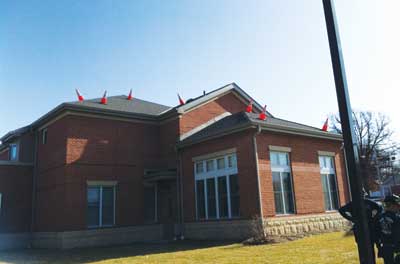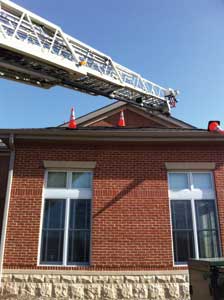By JASON HOEVELMANN
YOU MUST USE THE aerial device, like any other piece of equipment, regularly to be proficient with it. Considering that you drive this apparatus numerous times a day for inspections, public relations events, administrative duties, and emergency calls that do not require you to set up the device, the actual operation of the aerial is sometimes a forgotten art. However, when you need it at a fire, you need it immediately—without hesitation or mistakes. This article presents a drill to help with muscle memory and sighting the ladder or bucket.
First, find a building that is safe to use and offers accessibility to your apparatus. If you find a location that doesn’t block traffic, that is a plus. My department prefers to train on a roof with changing elevations and lines to make for a more challenging drill. The drill also requires the operator to look at different sight lines and elevation changes going from one station to the next instead of one, flat sight line. At fires, there are no easy situations, so we try not to train easy, either.
 |
| 1 Photos by author. |
Photo 1 shows cones placed on our roof; these are the taller orange cones that most departments have. We set up six to eight of these cones at different angles on the roof. Try not to line them up in a direct line with each other; each cone should be touched or knocked down on its own, not in pairs. The idea here is repetition.
We always keep two spotters on the roof. The spotters serve two purposes. The first purpose is to make sure that the roof doesn’t get damaged. The last thing we want is to damage a roof and ruin a good thing, especially if it is not department property. This also lends itself to the primary mission of the drill. We want the operator looking at the device and the tip—not at the controls. The second purpose is to make sure that no damage is done to the lights and the waterway on the aerial. You don’t want to have to replace parts on your device from damage caused during training.
This drill should build operators’ familiarity with which controls are needed and when, allowing them to watch for their task and to change conditions or unseen obstacles or hazards.
Another suggestion is to create a diagram of the controls with the layout and the sequence listed. This helps operators memorize the order of the hand controls on the turntable. You must also determine if the device has the option (pinnable waterway) to operate in “Fire” or “Rescue” mode. Ideally, you want the waterway out of the way so it does not inhibit your ability to get to the roof line or window (photo 2).
 |
| 2 |
The operators now put the truck and device to work. Each operator will start from the cab of the truck. The apparatus stays in one spot, but each operator must start anew on each evolution. Some discussions here include sizing up the area in which members are setting up, water supply sources, approaching corners of buildings, wind direction, and not parking too close to curbs and parked cars to allow proper outrigger and jack placement. You can also add cribbing to one side to simulate uneven surfaces to challenge the operator. This is all designed to keep them thinking; it’s not a mindless job. The crew can help with the jack pads and pins.
The operators now deploy the device. We will communicate from the roof on whether they need to knock the cone down completely or just touch it. We may also make operators use the nozzle to achieve this as well. This makes them operate the controls a little differently for each cone and doesn’t allow for “rhythm.”
You can also change it a bit by tying one of the cones to the last rung on the ladder or the bottom of the bucket. As they pass over the other cones, they must set the tethered cone on the stationary one before moving on. Once the cones are completed, the device is bedded and the system reset, and the next operator begins.
It’s important for the operators to spot the building with their device and to get confident in their abilities. We need to encourage and eventually require that they know what controls they are handling without looking. We need to instill in them the urgency of their having their eyes on the target—the building—during fire operations. If a crew is in trouble and needs that device fast, we want to watch where that device is going, not where our hands are going. In some cases, an operator who is still getting comfortable with the overall operations of the device may use two hands to control to become fluid and smooth. As his abilities and feel for the controls increase, so will his confidence.
We also encourage “feathering” the controls, which means to softly move the controls just enough to make the device move. This method decreases the likelihood of the device “slamming” or “flexing” when being moved. Discourage applying any torque to the device; with practice, operators will eliminate it by feathering and getting a feel for the operations.
Also, you can time the operators to add a little pressure and create some competition among trainees. Have operators compete against each other, house against house and crew against crew; it becomes fun! This drill builds muscle memory and can be done at no cost.
Some things to consider when performing this drill follow:
1 All personnel must wear a helmet with chin strap and gloves (photo 3).
 |
| 3 |
2 All personnel should be in radio contact so that any hazards can be pointed out.
3 Spotters should not approach an operating device. They should be in the line of sight of the operator at all times and have radios.
4 Always consider overhead obstructions during any aerial device operation.
5 Consider the parking surface and its durability.
6 If parked on the road, use cones to create a safe working space around the apparatus and a blocking vehicle behind it.
You can expand this drill depending on your creativity. It’s cheap and easy to do. Make it meaningful, realistic, and fun. You need to make sure your aerial operators are trained, confident, and ready for that 2:00 a.m. fire on a difficult building.
JASON HOEVELMANN is the training officer for the Florissant Valley Fire Protection District in St. Louis County, Missouri, and a deputy chief with the Sullivan (MO) Fire Protection District. He is co-owner of Engine House Training, LLC, and is a board member for the International Society of Fire Service Instructors. Hoevelmann has a bachelor’s degree from Eastern Oregon University in fire service administration and has been an instructor for more than 16 years.

